How Do Twitch Streamers Make Money? (2024 Guide)

Are you curious about how Twitch streamers earn a living by playing video games or simply talking live to a camera?
The Twitch website has become one of the biggest livestreaming platforms on the web, especially for streaming video game content.
In this post, we cover the biggest sources of revenue Twitch streamers use to make money.
How do Twitch Streamers make money?
With Twitch being one of the internet’s most-watched livestreaming platforms? It has a variety of different payout methods that are either built into or integrated with the platform.
They’re all similar to how other types of content creators and influencers make money, but each method is optimized specifically for Twitch.
But before we cover those methods, let’s go over what a Twitch streamer actually is.
What is a Twitch streamer?
In simplest terms, a Twitch streamer is a creator who streams live content to the Twitch livestreaming service.
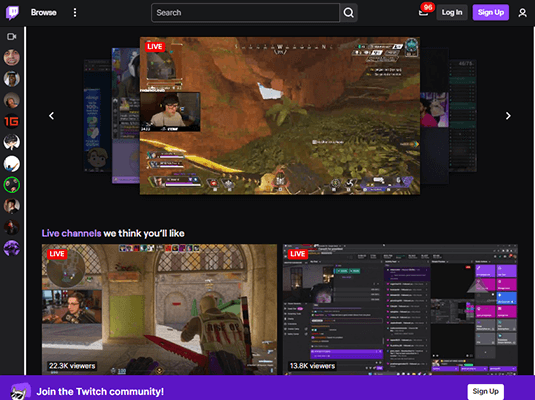
Streaming on Twitch is free for streamers, upfront at least. Twitch splits the cost of streaming with the streamer themselves through ad revenue and paid subscriptions.
A Twitch streamer’s public account is known as a “channel.” While their channel is live, the Twitch streamer can interact with their audience through a built-in live chat function.
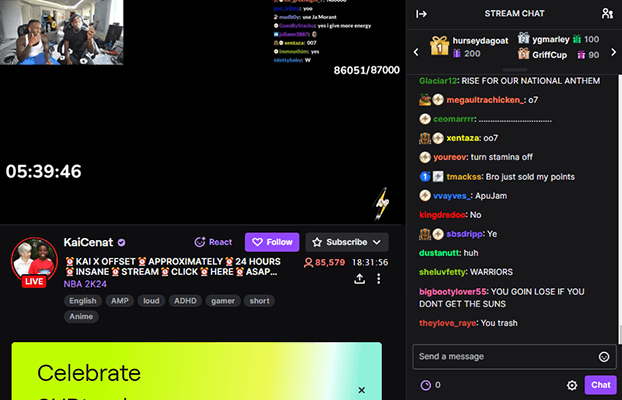
Viewers of the livestream can use the chat function to interact with other viewers, chat moderators and the streamer themselves.
Twitch streamers differ from other content creator types due to the fact that the majority of their content is streamed live.
This is in contrast to platforms like YouTube, TikTok, Instagram and Facebook. While these platforms have livestreaming formats, they’re primarily known for prerecorded/shot, on-demand content and text-based posts.
What types of Twitch streamers are there?
Twitch is mostly known as a livestreaming platform for gamers. That is, while YouTube is known for prerecorded let’s plays, Twitch is known as the place to go for watching streamers play video games live.
However, the platform has grown quite a bit over the last decade and has now become a common hub for all forms of live content, including podcasts, Dungeons and Dragons sessions, arts and crafts, mukbang, and even simple streamer-to-audience chats.
There are also differences in the tiers of streamers that exist on Twitch.
New streamers do not earn Twitch revenue by streaming on Twitch directly. Those benefits are reserved for Twitch partners and Twitch affiliates.
Both programs allow Twitch streamers to generate revenue through paid subscriptions, ads and bits.
However, they differ in streaming features with Twitch partners receiving far more benefits than Twitch affiliates.
It’s also easier to become a Twitch affiliate than it is a Twitch partner, a program in which acceptance is determined on a case-by-case basis.
In contrast, Twitch streamers can become affiliates by achieving a few requirements, including streaming for a minimum of 500 minutes over a 30-day period and receiving a minimum of 30 followers.
You can read more about the differences between the Twitch partner program and the Twitch affiliate program in our dedicated post on how to make money on Twitch.
How streamers make money on Twitch
Finally, let’s talk about the most common ways streamers make money on this platform:
- Subscriptions
- Ads
- Affiliate marketing
- Sponsorships
- Bits and live donations
- Merchandise
Twitch subscriptions
New streamers have one goal, and that’s to become a Twitch affiliate or partner. Paid subscriptions are why.
Paid subscriptions are a form of monthly recurring revenue for streamers. They come in three tiers, each of which provides more benefits than the last:
- Tier 1 – $4.99/month
- Tier 2 – $9.99/month
- Tier 3 – $24.99/month
Subscriptions give viewers access to ad-free viewing, exclusive, streamer-created emotes they can use in Twitch chat, access to sub-only chats and access to sub-only livestreams.
They also give viewers a way to support their favorite streamers.
For streamers, they receive 50% of each subscription they receive. Twitch takes the other 50% and only pays the streamer when they meet a $50 minimum threshold.
KaiCenat holds the record for the Twitch account with the most active subscriptions, which was 306,621 active subscribers at its peak (he currently has just over 80,000 active subscribers).
This means KaiCenat made $765,019 to $3,831,229 from Twitch subscriptions alone that month.
Ad revenue
Twitch streamers can still generate revenue from viewers who are not subscribed.
The most common way is through advertising revenue. Video ads interrupt livestreams periodically throughout the livestream’s duration.
Streamers earn 30 to 55% of the ad revenue their content generates. The percentage is based on the amount of ad time the streamer runs on their Twitch channel every hour.
Twitch partners can be invited into a special program that allows them to earn more ad revenue by completing specialized offers, such as earning $500 by running four minutes of ads every hour and streaming for a minimum of 40 hours throughout the month.
Affiliate marketing
Affiliate marketing is a fantastic source of revenue for content creators, especially smaller creators who aren’t yet eligible for sponsorships.
The same is true for smaller Twitch streamers who aren’t yet eligible for the platform’s partner programs.
Affiliate marketing is a revenue method in which a creator receives compensation for generating sales for a company.
It works like this: a creator recommends a product to their Twitch audience by promoting a special link that leads to that product.
The link is attributed to the creator, and when a member of their audience clicks it and completes a purchase, the creator earns a commission from the resulting sale, typically at a rate between 1 and 25%.
Most affiliate programs don’t have strict requirements for the number of followers or commissions you need in order to join or remain a part of them, which is why affiliate marketing is a fantastic revenue stream for small and larger creators alike.
On Twitch, streamers promote affiliate links by taking time out of their stream to promote products, promoting affiliate links with the use of chatbots and inserting affiliate links in the About section of their channel.
Sponsorships
Like Twitch subscriptions, sponsorships are another highly sought out revenue channel for Twitch streamers and are typically reserved for popular Twitch streamers.
This is because sponsorships work in a similar way as affiliate marketing in that streamers earn money for promoting a company’s products.
However, the two models differ in the amount streamers get paid and how they get paid.
With affiliate marketing, creators only earn when they generate sales, and those sales cannot result in returns or chargebacks.
Sponsors typically pay streamers upfront and negotiate promotion strategies.
This might involve demonstrating products live on stream, promoting products on social media, creating dedicated sponsor spots in the channel’s About section and even participating in sponsored events.
And because Twitch is primarily a gaming livestreaming platform, it’s not uncommon for entire livestreams to be sponsored. In this case, developers sponsor streamers and pay them to play newly released games live on stream.
Some sponsorships work a little differently in which a streamer and a sponsor will collaborate on a product. This is what G Fuel does with creators.
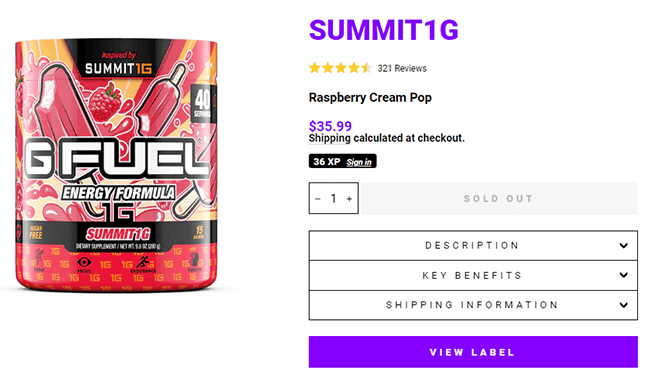
Twitch bits & live donations
This is another common revenue stream for Twitch streamers of all sizes, though Twitch bits are reserved for partners and affiliates.
Before Twitch bits were a thing, streamers typically set up what are known as “live donations” by linking their Twitch accounts to PayPal through a tool like Streamlabs.
This allows viewers to donate to Twitch streamers through PayPal while streamers are live.
Streamers typically set it up so that viewers can leave messages when they donate, then have that donation, the viewer’s username and the amount they donated appear live on screen.
Streamers typically respond to messages and thank viewers for donating.
It’s highly interactive for viewers, making it a fantastic revenue model for Twitch streamers.
Moving back to Twitch bits, bits are Twitch’s in-house donation system.
Viewers can purchase bits in bulk amounts ranging from 100 to 25,000 bits where 100 bits cost $1.40 and 25,000 bits cost $308.
Viewers can donate however many bits to streamers as they want, and the streamer earns $0.01 per bit.
But again, while any streamer can accept donations through PayPal and its competitors, only Twitch affiliates and partners can accept bits.
If you want to learn more, check out our post on how to setup donations on Twitch.
Merchandise
Finally, many Twitch streamers earn money by creating their own branded merchandise to sell.
Merch includes t-shirts, hats, drinkware, phone cases and more.
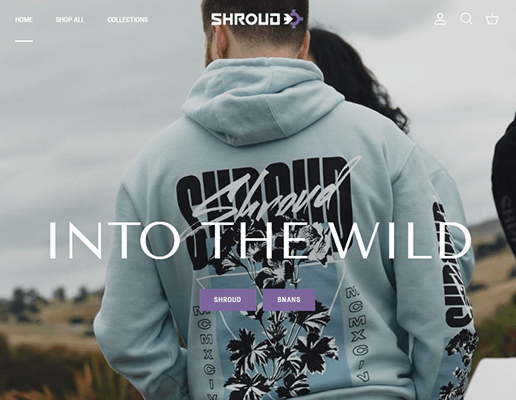
Small Twitch streamers are more likely to use print-on-demand services like Gelato, Printify and Printful while larger creators are able to collaborate with clothing brands and distributors to sell high-quality merch, though some larger creators stick with print-on-demand services.
Twitch is all about growing a highly-engaged audience who want to watch a streamer’s content.
It’s all about building a community, and creating merch plays a pretty big role in feeding that community in spite of it also being done to earn a profit.
Speaking of profit, let’s talk about how selling merch works.
When a streamer uses a print-on-demand service, they create a website on a platform like Shopify, WooCommerce or Squarespace.
They then upload their designs to the print-on-demand service’s website and use its built-in tool to choose how they’d like that design to appear on t-shirts and other merchandise.
After purchasing samples to confirm quality, the streamer can then launch their store.
When an order is placed, the print-on-demand service takes care of processing it and shipping it out to the streamer’s customer.
They even handle returns.
The reason print-on-demand services are popular among creators is because of the way they operate: the streamer only pays for the product when an order is placed.
They charge the customer more than what the print-on-demand service charges and keep the difference.
This way, there are no upfront costs, and the streamer doesn’t need to worry about storing merchandise or processing orders themselves. This allows small Twitch streamers to create merch much earlier in their careers.
Bigger creators may even hire a dedicated team to create merch and process orders.
How much do Twitch streamers make?
This is a hard question to answer because there is no set answer.
Streamers may get paid the same rate when it comes to things like subscriptions and bits, but they do not earn the same amounts month after month.
One Twitch streamer may earn revenue through subscriptions, bits and donations, merch, sponsorships, and affiliate links while another may simply rely on donations.
Many sponsors aren’t even interested in the number of followers or subscriptions a Twitch streamer has. They’re more concerned about the number of concurrent viewers a streamer receives per stream and over 30 to 90-day time periods.
Plus, Twitch streams are notorious for losing viewership after one hour, so sponsors may also be curious about the amount of viewers a streamer loses after streaming for an hour.
All of this plays a role in how much a streamer earns, and there are other factors to worry about as well.
If a streamer isn’t engaging enough, they won’t earn donations.
If a streamer doesn’t promote a company’s products well enough, they won’t earn affiliate commissions.
There are estimates about the earnings of top Twitch streamers, such as:
- Ninja – Estimated earnings of $5.42 million in 2023
- Shroud – $5.33 million
- xQc – $4.92 million
- Summit1g – $4.68 million
- Lirik – $3.89 million
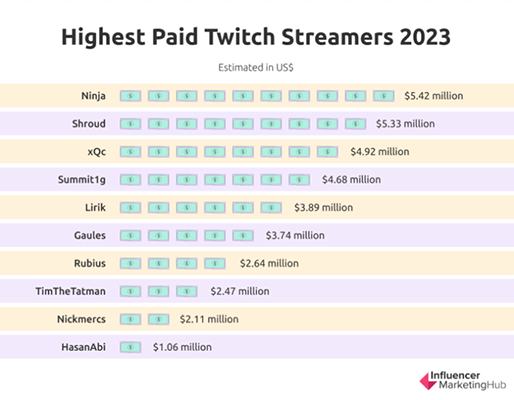
However, these Twitch channels have millions of followers and thousands of paid subscribers, so it’s hard to base the average streamer’s expected salary off of that.
We do know what streamers make per subscriber since we know that Twitch takes a 50% cut from each subscription.
- Tier 1 ($4.99) – Streamers make $2.49 per Tier 1 subscription.
- Tier 2 ($9.99) – Streamers make $4.99 per Tier 2 subscription.
- Tier 3 ($24.99) – Streamers make $12.49 per Tier 3 subscription.
Twitch’s minimum threshold for payouts is $50, which means a streamer will need 21 Tier 1 subscribers to receive a monthly $50 payout.
Let’s talk about bits. Streamers earn $0.01 per bit donated to their channel.
If a viewer purchases 100 bits for $1.40 and donates each one to a single streamer, that streamer will have made $1 whereas Twitch keeps the remaining $0.40.
Without subscriptions and ad revenue, a streamer needs to receive 5,000 bits in order to meet Twitch’s minimum $50 threshold for a payout.
Just how much money a streamer makes from all other revenue models discussed in this post are difficult to determine. It’s even difficult to determine how many subscribers or donations a streamer may receive based on the number of viewers they earn per stream.
Final thoughts
That concludes our post on how many streamers make money.
We discussed the most common ways Twitch streamers of all sizes generate revenue from the platform.
This means we left out a few additional sources of revenue, such as streamers creating their own products or uploading livestreams on YouTube to collect more ad revenue.
Even so, you now know how Twitch streamers earn a living by livestreaming gameplay and other content.
Just remember that while Twitch is most popular with video gamers, it’s also great for other types of content as well.
If you’d like to learn about how creators make money online in general, check out our post on how influencers make money.
Disclosure: Our content is reader-supported. If you click on certain links we may make a commission.
